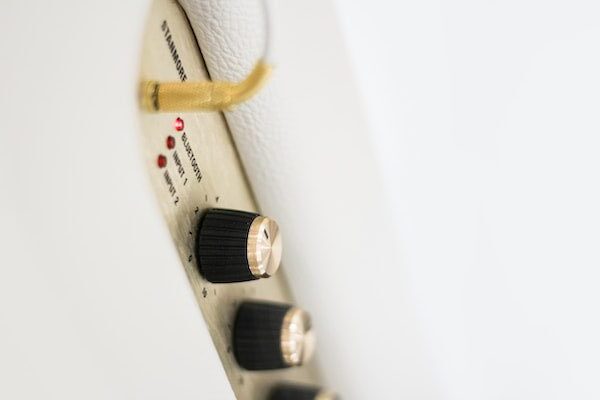Gain is a fundamental concept in audio that refers to signal amplification. In simple terms, the gain increases an audio signal’s strength.
Gain is a term used in audio engineering that refers to the amount of amplification applied to an audio signal. It is an essential concept in audio engineering, as it determines the level of the audio signal sent to the next stage of the audio processing chain. Gain is typically measured in decibels (dB), a logarithmic unit of measurement expressing the output level’s ratio to the input level.
Understanding gain is crucial for achieving high-quality audio recordings and performances. It allows sound engineers and musicians to control a signal’s volume and clarity and prevent distortion and noise. Gain is also important for achieving a balanced mix, where all instruments and vocals are heard clearly and at the right level.
Table of Contents

What is Gain?
Gain is an important factor to consider when working with audio equipment. It is used to adjust the level of a signal, ensuring that it is neither too quiet nor too loud. Gain can be adjusted at different stages of the audio signal chain, such as microphones, preamps, mixers, and amplifiers.
Definition of Gain
Gain is the level of amplification applied to an audio signal. It is the ratio of the output level to the input level, expressed in decibels (dB). Gain can be applied at different stages of the audio processing chain, including at the preamp stage, during mixing, and at the power amp stage.
Types of Gain
Several types of gain are used in audio engineering:
- Preamp Gain: This is the gain applied to an audio signal at the preamp stage. It boosts a weak audio signal to a level that the rest of the audio chain can process.
- Mixing Gain: This is the gain applied during mixing. It adjusts the level of individual tracks in a mix to achieve a balanced sound.
- Power Amp Gain: This gain is applied at the power amp stage. It boosts the audio signal to a level that can drive the speakers.
- Feedback Gain: This is the gain applied to an audio system’s feedback loop. It is used to stabilize the system and prevent oscillations.
Each type of gain serves a specific purpose in the audio processing chain, and it is important to understand how to use them effectively to achieve the desired sound.
How Gain Affects Audio
Gain is an essential component of audio systems, but it can positively and negatively affect audio quality. In this section, we will explore how gain affects audio.
Positive Effects of Gain
Increasing the gain can make audio signals louder, often necessary when recording or amplifying low-level signals. This can help to bring out the details and nuances of the sound, making it more audible and easier to distinguish from other sounds. Additionally, the gain can help to improve the signal-to-noise ratio, which is the ratio of the desired signal to the background noise. By boosting the desired signal level, the noise becomes relatively quieter, resulting in a cleaner and clearer sound.
Negative Effects of Gain
While gain can positively affect audio quality, it can also introduce unwanted distortion and noise. If the gain is too high, the audio signal can become clipped or distorted, resulting in a harsh, unpleasant sound. Additionally, increasing the gain can amplify any noise or interference in the signal, making it more noticeable and potentially degrading the overall audio quality.
It is important to find the right balance when setting the gain, as too little gain can result in a weak, indistinct signal, while too much gain can introduce unwanted distortion and noise. By carefully adjusting the gain, achieving the desired loudness level while maintaining a clean, clear sound is possible.
How to Adjust Gain
Adjusting gain is an essential step in achieving high-quality audio recordings. Proper gain adjustment ensures the audio signal is strong enough to be recorded without distortion but not so strong that it clips or distorts. Here are some tips for adjusting gain:
Tools for Adjusting Gain
Several tools can be used to adjust gain, including:
- Gain knobs on audio interfaces or mixers
- Software plugins or digital audio workstations
- External preamps
It is important to choose the right tool for the job and to understand how to use it properly.
Best Practices for Adjusting Gain
Here are some best practices for adjusting gain:
- Start with the gain knob or slider at its lowest setting and gradually increase it until the desired level is reached.
- Use a reference track to help set the gain level. A reference track is a professionally recorded track similar in style and instrumentation to the track being recorded. Set the gain level so that the recorded track matches the reference track in volume.
- Use a meter to monitor the level of the audio signal. Most audio interfaces and digital audio workstations have level meters that show the level of the audio signal in decibels (dB). Aim for a peak level of around -6 dB to -3 dB to leave headroom for any sudden peaks in the audio signal.
- Be aware of the proximity effect. The proximity effect is an increased bass response when a microphone is close to a sound source. This can cause the audio signal to become too bass-heavy if the gain level is too high. Adjust the gain level accordingly.
By following these best practices, achieving a clean, distortion-free recording with optimal gain levels is possible.
Final Thoughts on Audio Gain
Gain is an essential concept in audio that allows for precise control of sound levels. It is the measure of amplification between the input and output signals of an audio system. Gain can be adjusted to increase or decrease the volume of an audio signal without affecting its quality.
Different types of gain exist, including preamp gain, power amp gain, and feedback gain. Each type of gain has its unique characteristics and applications. Preamp gain boosts low-level signals from microphones or instruments, while power amp gain is used to amplify the signal to drive speakers or headphones. Feedback gain is used to control the stability and performance of an audio system.
Understanding the concept of gain is important to achieve optimal sound quality in any audio system. Proper gain staging is crucial to prevent distortion and noise in the signal path. By using gain appropriately, audio engineers and enthusiasts can achieve the desired sound quality and level without compromising the audio signal’s integrity.
- Review of the ALABS IRON MINI-WL: A Powerhouse Wireless Microphone - October 4, 2023
- What is a Saturator in Music Production: A Brief Explanation - May 11, 2023
- What Are Rotary DJ Mixers? An Overview - May 11, 2023
SoundStudiomagic.com is a participant in the Amazon Services LLC Associates Program, an affiliate advertising program designed to provide a means for sites to earn advertising fees by advertising and linking to Amazon.com. We also participate in other affiliate programs which compensate us for referring traffic.

